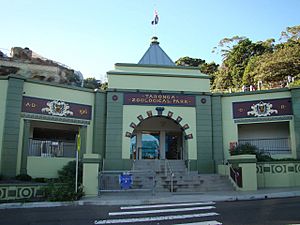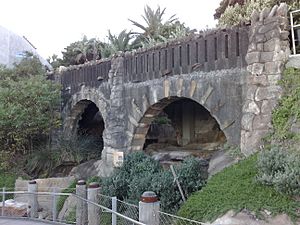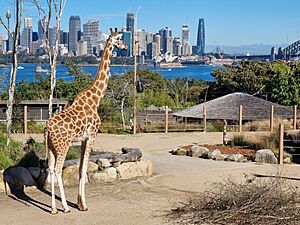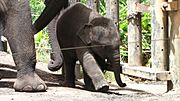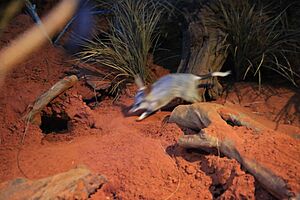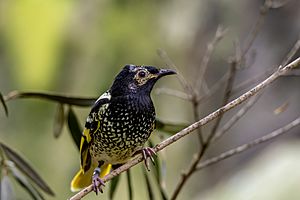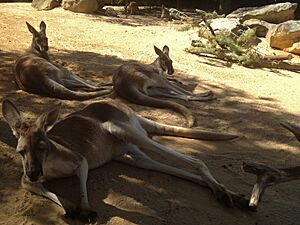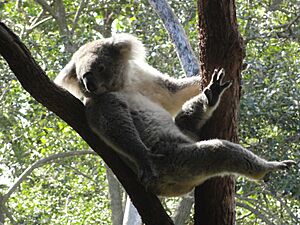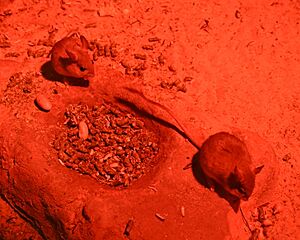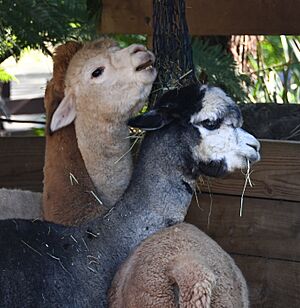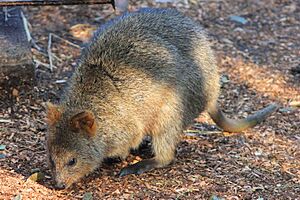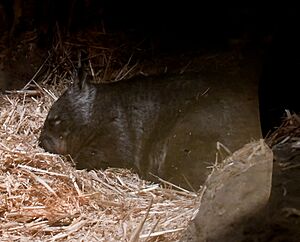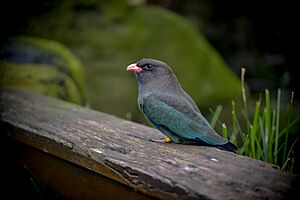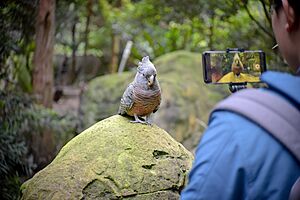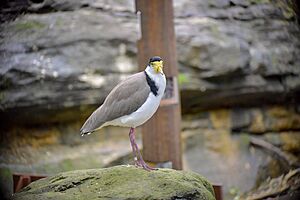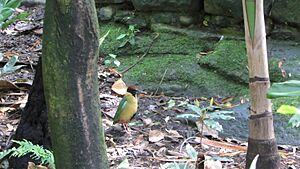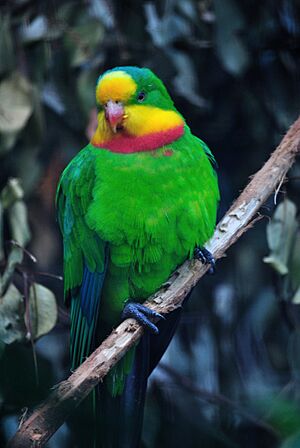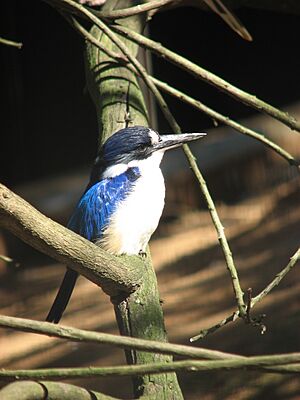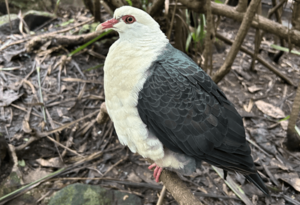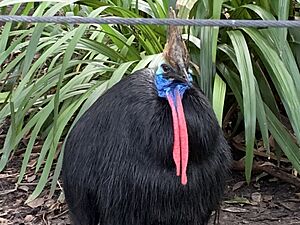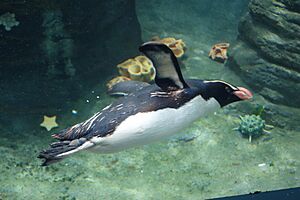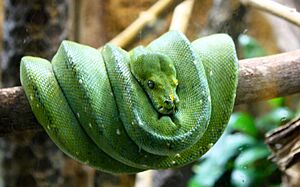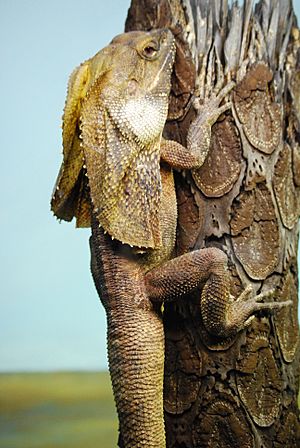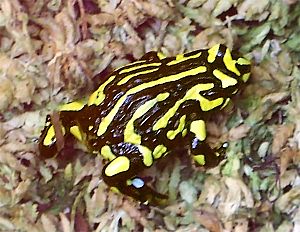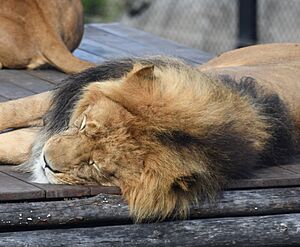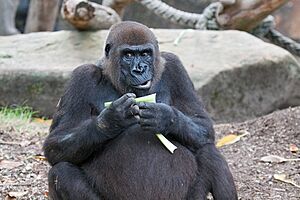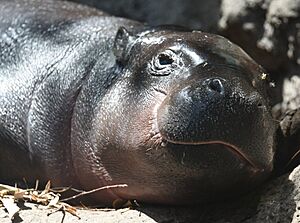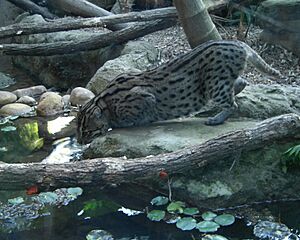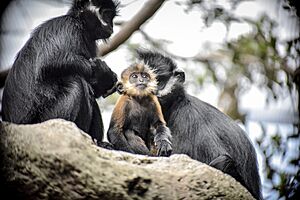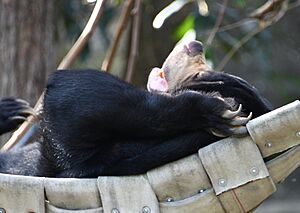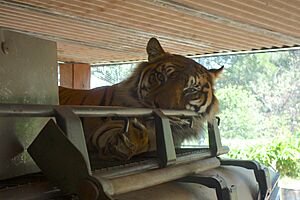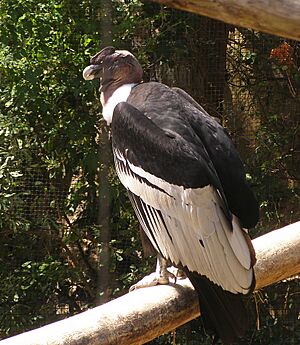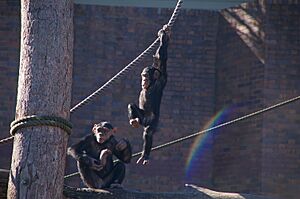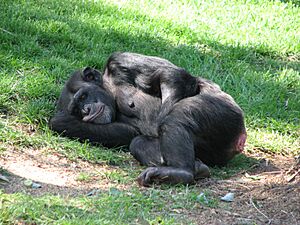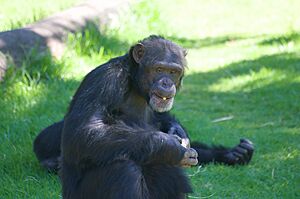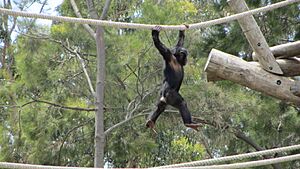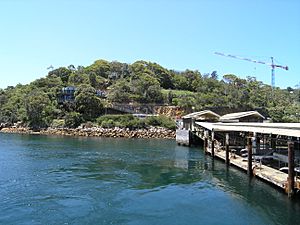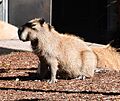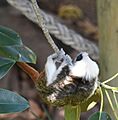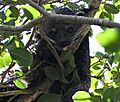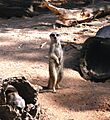Taronga Zoo facts for kids
Taronga Zoo Sydney is a public zoo run by the government. It is located in Mosman, a suburb of Sydney, New South Wales, Australia. The zoo sits right on the beautiful shores of Sydney Harbour, offering amazing views of the city and the water.
The word "Taronga" comes from an Aboriginal language and means "beautiful view." The zoo is open from 9:30 AM to 4:30 PM between May and August, and from 9:30 AM to 5:00 PM from September to April.
Taronga Zoo Sydney first opened its doors on October 7, 1916. It is managed by the Taronga Conservation Society, which also runs its sister zoo, the Taronga Western Plains Zoo in Dubbo.
This 28-hectare zoo is home to over 5,000 animals from about 350 different species. It is divided into areas based on where the animals come from in the world. The zoo also has a shop, a cafe, and an information center for visitors.

Taronga Zoo logo
|
|
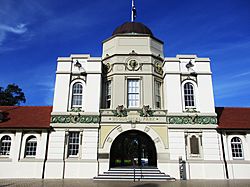
Taronga Zoo Sydney upper entrance
|
|
| Date opened | 7 October 1916 (1884 at Moore Park site) |
|---|---|
| Location | Bradleys Head Road, Mosman, Sydney, New South Wales, Australia |
| Land area | 28 hectares (69 acres) |
| Coordinates | 33°50′36″S 151°14′28″E / 33.84333°S 151.24111°E |
| No. of animals | 2,000+ |
| No. of species | 150+ |
| Memberships | ZAA |
| Top - 0-9 A B C D E F G H I J K L M N O P Q R S T U V W X Y Z |
History of Taronga Zoo
The first public zoo in New South Wales opened in 1884. It was run by the Royal Zoological Society of New South Wales. This first zoo was located at Moore Park, where Sydney Boys High School and Sydney Girls High School are today.
In 1908, the zoo's secretary, Albert Sherbourne Le Souef, visited the Hamburg Zoo. He was inspired by its new design, which used open spaces instead of bars for animals. He wanted to create a similar zoo in Sydney.
The Moore Park site was too small for this new vision. So, the NSW Government gave 43 acres of land north of Sydney Harbour. Another 9 acres were added in 1916. The new zoo, at its current location, opened on October 7, 1916.
Rustic Bridge: An Old Landmark
The "Rustic Bridge" was built in 1915. It was one of the first special features at Taronga Zoo. This bridge helped visitors cross a natural dip in the land. Old photos show it as a pretty path hidden by plants. Its design, with stones set into the walls, looked like Italian caves.
Changes in the Late 1900s
In 1967, a big review of the zoo happened. This led to a new focus on science, conservation, and education. New animal exhibits were built. These included homes for platypuses and nocturnal animals. There were also ponds for waterfowl and a walk-through rainforest aviary.
A special center for animal health was built. An Education Centre was also created to teach visitors. Old attractions like elephant rides and miniature trains were replaced. The zoo started focusing on learning experiences. These included Friendship Farm and the Seal Theatre.
Sky Safari Gondola
A cable car system, called the Sky Safari, was added in 1987. It was updated in 2000. This gondola carried visitors between the lower part of the zoo, near the ferry, and the top entrance. The Sky Safari closed on January 31, 2023. This was because it had reached the end of its working life. Plans are in progress to build a new, improved Sky Safari. It is scheduled to reopen in 2027-2028.
New Plans and the 2000s
In 2000, the zoo started a big 12-year plan. This plan involved spending $250 million to improve the zoo. The first major project was the Backyard to Bush area, which opened in April 2003.
As part of this plan, the zoo welcomed five Asian elephants from Thailand. These elephants were brought in for breeding, education, and conservation programs. They arrived in November 2006. The elephants and other Asian rainforest animals live in the Rainforest Trail area. This area opened in July 2005. It is designed to make visitors feel like they are in an Asian rainforest.
A marine section called Great Southern Oceans opened in April 2008. The zoo's historic entrance was also redeveloped and restored. The chimpanzee exhibit was expanded and reopened as the Chimpanzee Sanctuary. This gave the chimpanzees more space. It also made it easier to introduce new chimpanzees by allowing different areas within the exhibit.
The Tiger Trek area opened in August 2017. It features multiple exhibits for critically endangered Sumatran tigers.
The zoo's African Savannah area opened in June 2020. This was a major upgrade and expansion of the old giraffe and zebra yards.
In June 2024, Taronga Zoo opened the Amphibian & Reptile Conservation Centre (ARC).
Zoo Friends Membership
"Zoo Friends" is a yearly membership program. It gives members unlimited entry to both Taronga Zoo and Western Plains Zoo all year round. Members also get benefits like half-price parking, discounts at shops and cafes, and special access to events.
Education at the Zoo
The zoo works with TAFE and its Institute of Science and Learning. They offer special training courses. These programs teach about conservation, animal care, and wildlife management. Students get hands-on experience. This prepares them for jobs in wildlife conservation and caring for animals.
Special Moments at the Zoo
Platypus Birth
In February 2003, Taronga Zoo became the second zoo in Australia to successfully breed a platypus.
Australia's First Elephant Births
On July 4, 2009, at 3:04 AM, an Asian elephant named Thong Dee gave birth to a male calf. He was named Luk Chai. He was the first elephant calf born in Australia. Thong Dee and Luk Chai's father, Gung, were part of a program to help breed Asian elephants in Australia.
Luk Chai became a huge attraction. Thousands of visitors came to the zoo just to see him.
Another baby Asian elephant was born on March 10, 2010, at 3:27 AM. This calf was named Pathi Harn, which means "miracle" in Thai. Pathi Harn's father was Bong Su from Melbourne Zoo. This birth was achieved through artificial insemination.
The zoo's last two elephants, Pak Boon and Tang Mo, are moving in April 2025. They will live at Monarto Safari Park. Three elephants from Perth Zoo and Auckland Zoo will also join them there.
Royal Visit
On April 20, 2014, Prince William and Catherine, the Duchess of Cambridge, visited Taronga Zoo Sydney. They brought their 8-month-old son, Prince George. They took part in a ceremony at the bilby exhibit. The bilby was later renamed "Bilby George" in honor of the young prince. William and Kate visited the zoo again later without George to see other animals.
Birth of Sumatran Tiger Cubs
On January 17, 2019, Kartika, one of the zoo's four Sumatran tigers, gave birth to three cubs. There were two female cubs, Mawar and Tengah Malam, and one male cub, Pemanah. Sumatran tigers are critically endangered, with fewer than 350 left in the wild. Since 1980, a total of 21 tiger cubs have been born at Taronga.
Ongoing Conservation Work
For over fifty years, Taronga has been involved in many conservation programs. These programs help breed endangered and vulnerable species. The zoo changed its focus from just entertainment to helping animals threatened in the wild.
For example, Taronga has worked for over 20 years on the recovery program for the Regent Honeyeater. They have bred and released over 200 of these birds into the wild. This is a big help to their wild population. Taronga Zoo staff and volunteers have also planted over 30,000 trees in Capertee Valley. This helps restore the birds' natural home.
Pygmy Hippopotamus Calf Death
The zoo's female pygmy hippopotamus, Kambiri, gave birth to a female calf named Amara on November 22, 2021. Sadly, Amara died suddenly on December 24.
Leopard Seals at the Zoo
Taronga Zoo was once home to the only leopard seals living in a zoo. Leopard seals live in Antarctica. But sometimes, they come to Australia's coastlines in late winter. From 1999 to 2014, Taronga had three different leopard seals: Brooke, Sabine, and Casey. All three were found sick, hungry, or hurt on beaches.
It was decided not to return these seals to the wild after they recovered. This was to prevent them from possibly spreading unknown diseases to the fragile wild population. These three seals helped with important research. The Australian Marine Mammal Research Centre learned more about these animals. They studied things like whisker growth and how leopard seals hunt krill.
A new enclosure was built for the leopard seals. It was part of the Great Southern Ocean Exhibit, which opened in 2008. This exhibit now houses Australian sea lions, Californian sea lions, and New Zealand fur seals.
Brooke was the first leopard seal rescued in 1999. She was found underweight and injured. Keepers helped her get better. Brooke was very popular with staff and visitors. She was the first leopard seal ever displayed in a zoo. Brooke died on May 23, 2008, from an infection. She was believed to be around 10 years old.
Sabine was the second leopard seal to arrive in 2007. She was found very sick. Keepers nursed her back to health.
Casey was the last leopard seal at Taronga. He was found in 2007, also in poor health. Like the others, he could not be released. Casey and Sabine moved into the new Great Southern Ocean exhibit in 2008. Taronga Zoo hoped Casey and Sabine would have a baby. But Casey was too young when he was found to learn mating calls. Sabine died before he could learn them. Casey's health declined in 2014. He was humanely euthanized on February 20, 2014.
Animals and Exhibits
Taronga Zoo Sydney cares for about 5,000 animals. They represent over 350 different species. Many of these species are threatened in the wild. The animals live in many different exhibits, including:
Wild Australia
Nura Diya Australia
- Buru Nura (Kangaroo Country)
- Emu
- Kangaroo Island kangaroo
- Red kangaroo
- Red-necked pademelon
- Red-necked wallaby
- Swamp wallaby
- Tammar wallaby
- Gulamanu Nura (Koala Country)
- Wuragal Nura (Dingo Country)
Turtle Pool
Koala Walkabout
Tasmanian Devil Conservation Centre
Nguwing Nura (Nocturnal Country)
- Barton's long-beaked echidna
- Bilby
- Chuditch
- Fat-tailed dunnart
- Feathertail glider
- Ghost bat
- Long-nosed potoroo
- Platypus
- Rufous bettong
- Short-beaked echidna
- Spinifex hopping-mouse
- Yellow-bellied glider
Frogs
Backyard to Bush
- (House)
- Black house spider
- Children's python
- Giant golden silk orb-weaver spider
- Goliath stick insect
- Redback spider
- Spiny leaf insect
- St Andrew's cross spider
- Sydney banded huntsman spider
- (Backyard)
- (Farmyard)
- (Bush)
- (Wombat Burrow Tunnel)
- Barking tarantula
- Flinders Range scorpion
- Giant burrowing cockroach
- Hadra snail
- Southern hairy-nosed wombat
- Spinifex hopping-mouse
- Sydney funnel-web spider
Blue Mountains Bushwalk
- Australian zebra finch
- Blue-billed duck
- Brown cuckoo dove
- Brush bronzewing
- Brush-tailed rock wallaby
- Budgerigar
- Bush stone-curlew
- Chestnut-breasted mannikin
- Common bronzewing
- Crested pigeon
- Diamond firetail
- Dollarbird
- Eastern whipbird
- Freckled duck
- Gang-gang cockatoo
- Glossy black cockatoo
- Little lorikeet
- Masked lapwing
- Masked woodswallow
- Noisy pitta
- Pacific emerald dove
- Peaceful dove
- Platypus
- Plumed whistling duck
- Rainbow bee-eater
- Red-rumped parrot
- Regent bowerbird
- Regent honeyeater
- Rose-crowned fruit dove
- Sacred kingfisher
- Scaly-breasted lorikeet
- Striped honeyeater
- Superb lyrebird
- Superb parrot
- Swift parrot
- Welcome swallow
- White-browed woodswallow
- Wonga pigeon
Australian Rainforest Aviary
- Australian king parrot
- Black-faced monarch
- Blue-faced parrot-finch
- Brown cuckoo dove
- Double-eyed fig-parrot
- Eastern whipbird
- Eclectus parrot
- Forest kingfisher
- Golden whistler
- Macleay's fig parrot
- Metallic starling
- Musk lorikeet
- Noisy pitta
- Pacific emerald dove
- Regent bowerbird
- Rose-crowned fruit dove
- Superb fruit dove
- Topknot pigeon
- Torresian imperial pigeon
- White-headed pigeon
- Wompoo fruit-dove
Semi-Arid Aviary
- Common bronzewing
- Diamond firetail
- Eastern yellow robin
- Freckled duck
- King quail
- Little lorikeet
- Masked woodswallow
- Mulga parrot
- Rainbow bee-eater
- Red-headed honeyeater
- Silvereye
- Splendid fairywren
- Sugarbag bee
- Swift parrot
- Turquoise parrot
- Welcome swallow
- White-breasted woodswallow
Other Australian Birds
- Australian reed-warbler
- Barking owl ('Free Flight' bird show)
- Black-breasted buzzard ('Free Flight' bird show)
- Bush stone-curlew ('Free Flight' bird show)
- Crimson finch
- Double-barred finch
- Gouldian finch
- Lesser sooty owl ('Aussie Animals Alive' show)
- Masked finch
- Pied stilt
- Purple-backed fairywren
- Red-tailed black cockatoo ('Free Flight' bird show)
- Rufous whistler
- Southern cassowary
- Spinifex pigeon
- Star finch
- Sulphur-crested cockatoo ('Free Flight' bird show and free roaming)
- Variegated fairywren
Great Southern Oceans
- Australian pelican
- Australian sea lion
- California sea lion
- Fiordland penguin
- Little penguin
- Long-nosed fur seal
Amphibian & Reptile Conservation Centre
- Alligator snapping turtle
- Bellinger River turtle
- Black headed python
- Boa constrictor
- Booroolong frog
- Boyd's forest dragon
- Broad-headed snake
- Canberra grassland earless dragon
- Central netted dragon
- Centralian carpet python
- Centralian rough knob-tailed gecko
- Chinese three-striped box turtle
- Common death adder
- Corn snake
- Eastern blue tongue lizard
- Eastern diamondback rattlesnake
- Eastern dwarf tree frog
- Eastern Pilbara spiny-tailed skink
- Elongated tortoise
- Emerald tree monitor
- Fijian crested iguana
- Frilled lizard
- Gila monster
- Green tree python
- Indian star tortoise
- Inland taipan
- Lace monitor
- Mary River turtle
- Merten's water monitor
- Monocled cobra
- Pygmy python
- Plumed basilisk
- Red-bellied black snake
- Red-barred dragon
- Red-eyed tree frog
- Reticulated python
- Rhinoceros iguana
- Rusty desert monitor
- Scheltopusik
- Scrub python
- Shingleback lizard
- Slater's skink
- Southern corroboree frog
- Tiger snake
- Tuatara
- White-lipped tree frog
- Yellow spotted bell frog
African Savannah
- African lion
- Fennec fox
- Giraffe
- Helmeted guineafowl (free roaming)
- Meerkat
- Ostrich
- Plains zebra
Chimpanzee Sanctuary
Gorilla Forest
Rainforest Trail
- Asian small-clawed otter
- Binturong
- Bolivian squirrel monkey
- Eastern bongo
- Egyptian goose
- Fishing cat
- François' langur
- Pygmy hippopotamus
- Red junglefowl
- Ruddy shelduck
- (Palm Aviary)
- (Wetland Aviary)
Sun Bear Canyon
Tiger Trek
- Red junglefowl (free roaming)
- Sumatran tiger
Primate Islands
Other Species
- Australian brushturkey (wild free roaming)
- Australian white ibis (wild free roaming)
- Aldabra giant tortoise
- Andean condor
- Blue peafowl (free roaming)
- Capybara
- Eastern water dragon (wild free roaming)
- Goodfellow's tree-kangaroo
- Laughing kookaburra (wild free roaming)
- Red panda
- Ring-tailed lemur
Taronga Institute of Science & Learning
- Agile wallaby
- Australian green tree frog
- Black headed python
- Cane toad
- Central bearded dragon
- Chaco tortoise
- Common wombat
- Common ringtail possum
- Diamond python
- Eastern long-neck turtle
- Eastern quoll
- Inland carpet python
- Ornate box turtle
- Pygmy marmoset
- Spotted python
- Squirrel glider
- Tawny frogmouth
- Waigiensis rainforest scorpion
Wildlife Retreat Hotel
- Banded archerfish
- Eel-tailed catfish
- Estuary glassfish
- Freshwater forktail catfish
- Koala
- Platypus
- Red-necked pademelon
- Rufous bettong
- Saltwater crocodile
- Short-beaked echidna
- Short-finned eel
- Southern saratoga
- Swamp wallaby
- Tammar wallaby
Future Plans
The zoo has announced some exciting plans for the future:
- A new wildlife hospital will replace the old reptile center.
- Asian elephants Pak Boon and Tang Mo are moving to Monarto Safari Park in 2025.
- Greater one-horned rhinoceroses and Asian water buffalo will share a new 'Rhino Reserve' habitat.
- A new Congo rainforest area is planned.
- Philippine crocodiles will join the Reptile & Amphibian building.
Chimpanzee Community
Taronga Zoo is home to a group of 21 chimpanzees. They are of different ages and include both males and females.
Male Chimpanzees
- Samaki was born in November 2001. He is now the leader of the group. He is the father of Cebele.
- Shabani was born in September 1994. He is Samaki's older brother. He is not very patient with the baby chimpanzees.
- Furahi was born in February 2003. He is close to his mother, Kuma. He helped her raise his younger brother, Fumo.
- Shikamoo was born in July 2003. He is good friends with Furahi. He is protective of his brother, Sule. Shikamoo is the father of Fumo.
- Sule was born in April 2008. He was the youngest for five years. He often helped care for Fumo when he was little. Sule is currently the leader of the group. He is known for being a peacemaker.
- Fumo was born in October 2013. He is the oldest of the four young chimpanzees. He is very good at climbing. Fumo has a good relationship with Cebele, the youngest.
- Sudi was born in August 2014. His mother, Shiba, kept him very close when he was young.
- Liwali was born in September 2014. He was the youngest for three years until Cebele was born. He is close to Fumo and Sudi.
- Niambi was born in October 2020.
Female Chimpanzees
- Lisa was born in August 1979 at Taronga Zoo. She is the highest-ranking female and the oldest chimpanzee in the group. She has had five babies.
- Sasha was born in June 1980 at Taronga Zoo. She has had six babies.
- Shiba was born in May 1981. She is a strong and independent female. She is very protective of her children.
- Shona was born in October 1987. She is the lowest-ranking adult female. She has a good relationship with Kamili.
- Kuma was born in December 1991. She has had three babies. She is a strong female and has moved up in the group's social order.
- Kamili was born in September 1995. She has had three babies, but sadly, none survived. She is close to Shona.
- Sembe was born in February 2008. She is very close to her mother, Shiba. She is a lively young female.
- Naomi was born at Givskud Zoo in Denmark. She has adjusted well to the group.
- Ceres was born at Givskud Zoo in Denmark. She had a daughter named Cebele on November 14, 2017. Ceres was very protective of Cebele. Sadly, Cebele died in July 2023 from an illness.
- Safiri was born in May 2019.
- Lemba was born in May 2023.
- Cekiri was born in July 2023. She is currently the youngest chimpanzee in the group.
Past Chimpanzees
- Lubutu was born in June 1993. He was the leader of the chimpanzee group for a long time. He was known for being fair and playing with the young chimpanzees. Lubutu died in December 2019.
- Spitter was born in June 1960 at Taronga Zoo Sydney. She had seven babies. Spitter died in March 2022.
- Koko was born in the wild in January 1972. She came to Taronga Zoo Sydney in February 1993. She had five babies, but none survived. Koko died in May 2019.
Getting to the Zoo
Many tourists like to take the ferry to Taronga Zoo. The ferry ride from the city to the zoo takes about 12 minutes. When passengers get off at the Taronga Zoo ferry wharf, they can enter the zoo through the lower entrance. Or, they can take a local bus to the top entrance.
Taronga Zoo Sydney also works with other Sydney Harbour transport companies. These include Captain Cook Cruises and Yellow Water Taxis. Both offer special tickets that include both transport and zoo entry.
Conservation Efforts
Taronga Zoo works hard to protect animals and the environment. They try to reduce human impact and keep nature healthy. They do this work in Australia and around the world.
Legacy Species Program
In 2016, the zoo started a special program called Legacy Species. For the next ten years, they focused on helping ten very important species. Five of these are native to Australia: the Koala, Regent Honeyeater, Southern Corroboree Frog, Marine Turtles, Platypus, and Greater Bilby. The other five are close to extinction in Sumatra: the Sumatran Rhinoceros, Sumatran Tiger, Asian Elephant, Sun Bear, and Sunda Pangolin.
Waste Management
The zoo also focuses on reducing waste. They send 84% of their waste away from landfills. This waste goes to 20 different recycling or composting streams. A big focus is on single-use plastics. The zoo encourages visitors to use reusable bags, water bottles, and coffee cups. They also use biodegradable bags and food packaging. During the Seal talk, the zoo promotes choosing sustainable seafood. They encourage looking for the MSC label.
Incidents
2022 Lion Escape
On November 2, 2022, at 6:40 AM, five African lions got out of their enclosure. Police were called to the zoo around 7:00 AM. No one was hurt. The lions were returned to their enclosure, and one cub was tranquilized. On December 1, 2022, video footage showed the lions escaping through a hole in a fence.
Images for kids
-
Cotton-top tamarin on Moreton Bay fig
See also
 In Spanish: Zoológico Taronga para niños
In Spanish: Zoológico Taronga para niños
- Taronga Conservation Society
- Taronga Western Plains Zoo
- Taronga by Victor Kelleher, a work of fiction using Taronga Zoo as its setting


